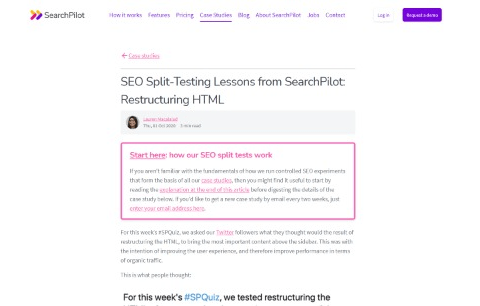

Restructuring HTML SEO Split Testing Lessons from SearchPilot
Restructuring HTML SEO Split Testing Lessons from SearchPilot
For this week’s #SPQuiz, we asked our Twitter followers what they thought would the result of restructuring the HTML, to bring the most important content above the sidebar. This was with the intention of improving the user experience, and therefore improve performance in terms of organic traffic.
This is what people thought:
Poll result showing 61% of people voting for positive
The response was very one-sided: 61% of people thought it would have a positive result, with only 3% thinking this would have a negative impact. In this case, the majority was correct! As you’ll read below, this test gave a 16% uplift to the pages where we made this change.
The Case Study
User experience and SEO are overlapping more and more these days. We heard directly from Google (via Google Webmasters on twitter) that future page experience updates will further consider UX-related signals for rankings.
The layout of a page can affect a user’s experience, including which bits of content the user focuses on and takes in. In addition, the way and order the page renders can change their impression of the page and whether it meets their needs. In other words, even with the same content present in the HTML, different ordering can cause different first impressions and can strongly influence whether a user stays on the page or leaves.
Before testing the page layout, our client, a coupon aggregator site, had product pages that would load the sidebar content before the coupon content. The sidebar content provided the user with general information on the store along with miscellaneous details on how many offers are currently available, store contact information, and additional ways to save when shopping via said store. The sidebar content did not however show actual coupons – which were the primary user intent of searchers landing on these pages. Taking this into consideration, if a page were slow to load, the user would first see the sidebar content and may think the page wouldn’t deliver on the content they intended to find. They’d navigate back to the SERP and take their organic traffic ‘business’ elsewhere.
